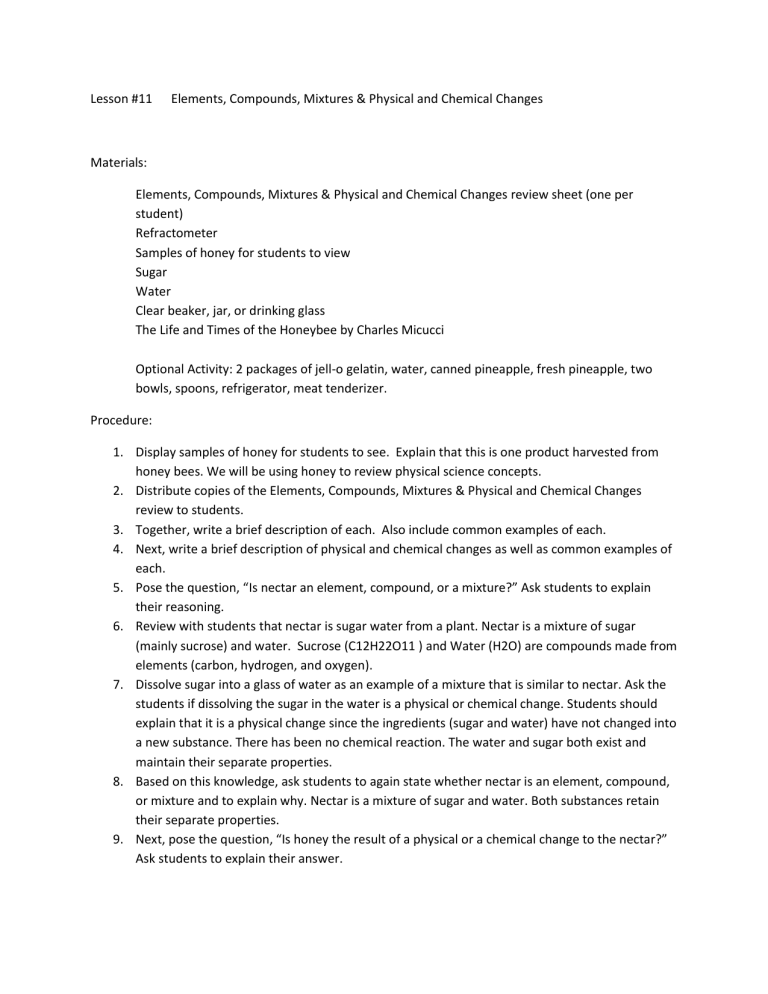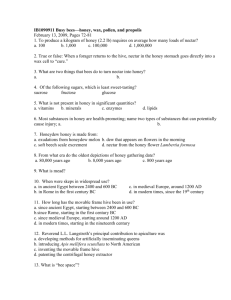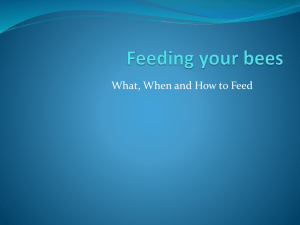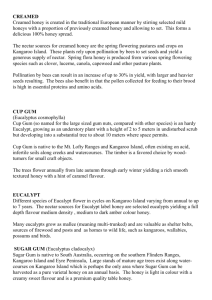Lesson #11 Elements, Compounds, Mixtures & Physical and

Lesson #11 Elements, Compounds, Mixtures & Physical and Chemical Changes
Materials:
Elements, Compounds, Mixtures & Physical and Chemical Changes review sheet (one per student)
Refractometer
Samples of honey for students to view
Sugar
Water
Clear beaker, jar, or drinking glass
The Life and Times of the Honeybee by Charles Micucci
Optional Activity: 2 packages of jell-o gelatin, water, canned pineapple, fresh pineapple, two bowls, spoons, refrigerator, meat tenderizer.
Procedure:
1.
Display samples of honey for students to see. Explain that this is one product harvested from honey bees. We will be using honey to review physical science concepts.
2.
Distribute copies of the Elements, Compounds, Mixtures & Physical and Chemical Changes review to students.
3.
Together, write a brief description of each. Also include common examples of each.
4.
Next, write a brief description of physical and chemical changes as well as common examples of each.
5.
Pose the question, “Is nectar an element, compound, or a mixture?” Ask students to explain their reasoning.
6.
Review with students that nectar is sugar water from a plant. Nectar is a mixture of sugar
(mainly sucrose) and water. Sucrose (C12H22O11 ) and Water (H2O) are compounds made from elements (carbon, hydrogen, and oxygen).
7.
Dissolve sugar into a glass of water as an example of a mixture that is similar to nectar. Ask the students if dissolving the sugar in the water is a physical or chemical change. Students should explain that it is a physical change since the ingredients (sugar and water) have not changed into a new substance. There has been no chemical reaction. The water and sugar both exist and maintain their separate properties.
8.
Based on this knowledge, ask students to again state whether nectar is an element, compound, or mixture and to explain why. Nectar is a mixture of sugar and water. Both substances retain their separate properties.
9.
Next, pose the question, “Is honey the result of a physical or a chemical change to the nectar?”
Ask students to explain their answer.
10.
Read and show pictures from pages 16-17 in the book, “The Life and Times of the Honeybee” by
Charles Micucci. These pages explain how bees produce honey.
11.
After the video, ask students how honey differs from nectar.
12.
Complete the Venn diagram comparing and contrasting honey and nectar. Be sure to review with students the following concepts: a.
Like nectar, honey is a mixture of sugar and water. b.
The sugar in the honey is more concentrated than the sugar in nectar. c.
The concentration of sugar increases as water evaporates. d.
The sugar in honey is also different from the sugar that was in the nectar. While nectar contains sucrose, honey is mainly glucose and fructose.
13.
Ask students where the glucose and fructose in honey come from. Bees add the enzyme invertase to the nectar. Invertase will break the sucrose into fructose and glucose.
14.
Ask students if the enzyme causes a physical or chemical change. Since new substances are produced, this is a chemical change.
15.
Optional activity to demonstrate enzyme action: Make one bowl of jell-o with canned pineapple and another bowl of jell-o with fresh pineapple. Check the jell-o the following day and have students make observations and compare the two bowls of jell-o. The jell-o made with fresh pineapple will be runny. An enzyme in fresh pineapple, bromelain, breaks protein bonds of the gelatin. The enzyme in the canned pineapple was destroyed by heat during the canning process.
The enzyme in pineapple, bromelain, is used in meat tenderizer. The enzyme breaks down protein in the meat to make the meat tender. Ask students how bromelain is similar to invertase.
16.
Ask students again if honey is created through physical or chemical changes. Ask them to support their answer with a description of the changes the nectar must undergo to become honey.
17.
Lead students to the understanding that honey is the result of both physical and chemical changes. Enzymes from the bee react (chemical change) with sugar in the nectar to create new substances. Also, water from the nectar evaporates (physical change) and concentrates the sugars.








